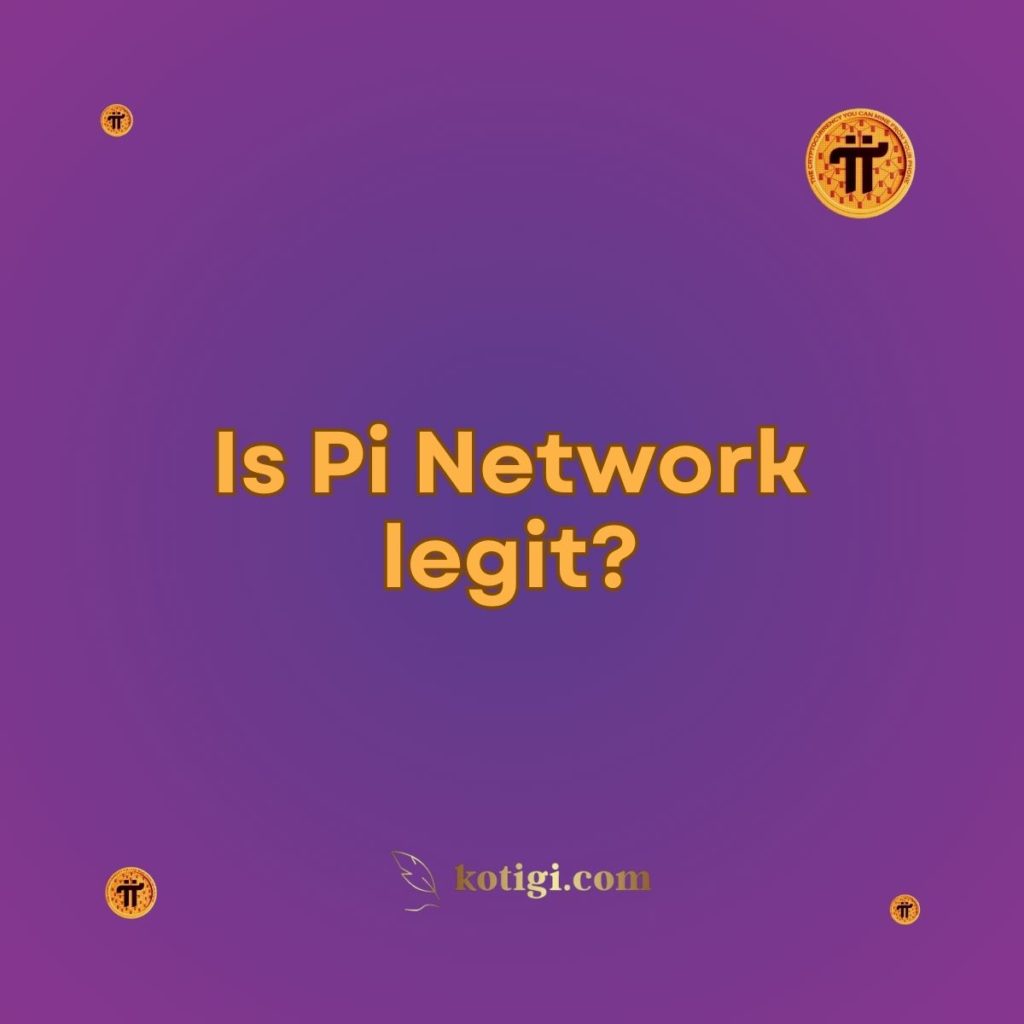
Is Pi Network legit?
Pi Network claims to be a decentralized cryptocurrency project that allows users to mine Pi coins via a mobile app. While it has attracted millions of users, Pi Network is still in its enclosed mainnet phase, and its legitimacy has been the subject of debate. The project’s future will depend on its transition to the open mainnet and whether it delivers on its promises of decentralization and utility. Until then, Pi’s legitimacy remains uncertain, but there is no evidence of it being an outright scam.
Introduction
Pi Network has garnered significant attention since its launch, amassing millions of users (known as “Pioneers”) who mine its cryptocurrency on their mobile phones. Its easy mining process and bold claims about the future of decentralized finance have made it a popular project. However, Pi Network’s legitimacy is a topic of ongoing debate. This article will explore whether Pi Network is legit, its current status, and the factors that could determine its future.
Understanding Pi Network
What Is Pi Network?
Pi Network is a cryptocurrency project founded by Stanford graduates in 2019. The project claims to offer a new, decentralized cryptocurrency (Pi coin) that can be mined using a mobile app, making it accessible to the general public without the need for energy-intensive hardware. Users mine Pi by tapping a button daily on the app, simulating the traditional cryptocurrency mining process in a simplified manner.
How Does Pi Network Work?
Pi Network’s mining process is one of its most unique features. Unlike Bitcoin and other traditional cryptocurrencies that require significant computational power, Pi uses a consensus algorithm known as Stellar Consensus Protocol (SCP). This allows users to participate in securing the network without consuming a large amount of energy.
Mining Pi requires minimal effort—users need to open the Pi app and click the mining button once every 24 hours. The app does not drain battery life or require users to keep it open continuously, which is one reason it has gained such widespread adoption.
Factors Supporting Pi Network’s Legitimacy
Team of Stanford Graduates
One of the main factors that lend credibility to Pi Network is its founding team, which consists of Stanford graduates: Dr. Nicolas Kokkalis, Dr. Chengdiao Fan, and Vincent McPhillip. Their educational and professional backgrounds provide a layer of trust for some users who see their involvement as a sign of the project’s legitimacy.
Growth in User Base
Pi Network boasts a large and growing user base, with over 35 million registered users as of 2023. The app’s ease of use and its promise of making cryptocurrency accessible to the masses have attracted significant attention. This large user base suggests that many people believe in the project’s potential, even if its long-term viability is still uncertain.
Focus on Decentralization
Pi Network claims to prioritize decentralization, similar to Bitcoin’s vision. According to its whitepaper, Pi aims to create a fully decentralized network that allows users to take part in securing the blockchain and validating transactions without the need for energy-consuming mining rigs. This focus on a more energy-efficient and accessible mining process is one of the reasons it has gained popularity.
Concerns About Pi Network’s Legitimacy
No Open Mainnet Yet
One of the major concerns surrounding Pi Network is the fact that it is still in its enclosed mainnet phase. During this phase, Pi coins cannot be transferred out of the Pi Network ecosystem, and they are not listed on any cryptocurrency exchanges. This has led to skepticism about whether Pi coins will ever have any real value.
The project has repeatedly delayed the launch of its open mainnet, raising questions about its development progress and whether Pi coins will ever become tradable on public exchanges. Until the open mainnet is launched, Pi users cannot sell or trade their coins for other cryptocurrencies or fiat currency, leaving the project’s future value in question.
Lack of Transparency on Use Cases
While Pi Network has ambitious goals of creating a decentralized economy, it has yet to provide clear details on the specific use cases for Pi coins. Other major cryptocurrencies, such as Bitcoin and Ethereum, have well-defined roles in decentralized finance (DeFi), payments, and smart contracts. In contrast, Pi’s real-world utility remains vague, with no concrete examples of how Pi coins will be used beyond the network’s internal ecosystem.
Without a clear plan for creating value and utility for Pi coins, it is difficult for users to assess the project’s long-term viability.
No Monetary Investment Required
One argument Pi Network supporters use to defend its legitimacy is that the project does not require any monetary investment. The mobile app is free to use, and users do not have to spend money to mine Pi coins. This has led some to argue that, even if the project fails, users have not lost any money.
However, critics point out that Pi Network collects valuable user data, including personal information through the KYC (Know Your Customer) process. This has raised concerns about privacy and whether the project’s true aim is to collect and monetize user data rather than build a decentralized cryptocurrency.
Delays in Open Mainnet Launch
A major concern for Pi Network is the delay in transitioning from its enclosed mainnet to an open mainnet. Currently, Pi coins cannot be transferred or traded outside the network, limiting their practical use and value.
The delays in launching the open mainnet raise questions about the project’s ability to deliver on its promises and the feasibility of its long-term goals. Until this transition occurs, the future value of Pi coins remains uncertain.
Lack of Clear Use Cases
Pi Network has yet to provide specific details on how Pi coins will be used beyond the internal ecosystem. Unlike established cryptocurrencies with defined roles in decentralized finance, payments, or smart contracts, Pi’s use cases remain vague.
The lack of concrete use cases for Pi coins makes it difficult to assess the project’s potential for real-world application and adoption.
Privacy and Data Collection
Pi Network collects personal information through its Know Your Customer (KYC) process, which includes verifying users’ identities. While KYC is a standard practice for regulatory compliance, some users are concerned about how their data is handled and stored.
The project’s approach to data privacy and security will be crucial in determining user trust and the overall legitimacy of the network.
Is Pi Network a Scam?
What Defines a Scam?
A scam typically involves fraudulent activity where users are deceived into losing money, data, or other valuable assets. While Pi Network has raised concerns, there is no direct evidence that it is a scam in the traditional sense. Users are not required to invest money, and there is no indication that the founders are attempting to defraud participants.
That being said, the project’s lack of transparency and delay in delivering key milestones, such as the open mainnet, have led some to view Pi Network with skepticism.
Why Some Believe Pi Is Not a Scam?
Some proponents argue that Pi Network is simply a long-term project, and its slow development is a result of careful planning and security measures. The founding team has emphasized that decentralization takes time, and they aim to build a sustainable cryptocurrency with real-world utility.
They point to the large user base, the team’s professional credentials, and the absence of any financial investment requirement as evidence that Pi is not a scam, but rather a legitimate experiment in decentralized finance.
Potential Risks for Pi Network Users
Privacy Concerns
As part of the KYC process, Pi Network collects personal information from users, including government-issued IDs. While KYC is a standard practice in the cryptocurrency industry, some users are concerned about how their personal data is stored and used. Pi Network’s privacy policies will be a key factor in determining the level of trust users place in the project.
Market Volatility
If and when Pi becomes publicly tradable, users should be prepared for significant price volatility. New cryptocurrencies often experience sharp price fluctuations due to speculation, low liquidity, and uncertainty about long-term value. Users who plan to trade Pi should be cautious and avoid making hasty investment decisions.
Uncertain Value
Another risk is the uncertainty surrounding the value of Pi coins once they become tradable. While some users hope that Pi will achieve significant value, similar to Bitcoin or Ethereum, others caution that the price of Pi could be low due to its large supply and lack of established utility.
The true value of Pi will depend on whether the project can create real-world use cases and attract adoption from both users and developers.
Risks and Challenges for Pi Network
Regulatory Risks
Cryptocurrency projects face significant regulatory challenges, and Pi Network is no exception. As the project aims to create a decentralized digital currency, it must navigate a complex regulatory landscape that varies by country. Regulations concerning cryptocurrencies are evolving, and compliance with local laws is crucial for the project’s success.
The project must ensure that it adheres to anti-money laundering (AML) and know-your-customer (KYC) regulations. Failure to comply with regulatory requirements could result in legal issues and hinder Pi Network’s ability to operate in certain jurisdictions.
Competition in the Cryptocurrency Space
Pi Network is entering a highly competitive cryptocurrency market. Established cryptocurrencies like Bitcoin, Ethereum, and newer projects such as Solana and Polkadot have already built substantial ecosystems and user bases. Pi Network will need to differentiate itself and demonstrate its value proposition to compete effectively.
The success of Pi Network will depend on its ability to attract users, developers, and businesses to its ecosystem. Without a compelling value proposition and unique features, Pi may struggle to gain traction in a crowded market.
Scalability and Security
Scalability and security are critical considerations for any blockchain project. Pi Network’s use of the Stellar Consensus Protocol aims to address these issues by providing a more energy-efficient consensus mechanism. However, the project must prove that it can scale effectively as the number of users grows and maintain high levels of security against potential attacks.
The transition to the open mainnet will be a key test of Pi Network’s scalability and security. The project must demonstrate that it can handle increased transaction volumes and maintain network integrity under real-world conditions.
Pi Network’s Path to Legitimacy
Transition to Open Mainnet
The most critical factor in determining whether Pi Network is legitimate will be the successful transition to the open mainnet. This step is necessary for Pi coins to gain value and be traded on public exchanges. Until Pi makes this transition, the project’s value proposition remains largely speculative.
The open mainnet will also allow users to transfer Pi coins out of the network, providing more transparency and potentially reducing skepticism about Pi’s legitimacy.
Exchange Listings
If Pi Network can successfully transition to the open mainnet, the next step will be getting listed on cryptocurrency exchanges. These listings will allow users to trade Pi coins for other cryptocurrencies or fiat currency, giving them a tangible value.
Exchanges like Binance, Coinbase, or Kraken may be potential candidates for listing Pi, but the project will need to meet the security, liquidity, and regulatory standards required by these platforms.
Regulatory Compliance and KYC
Pi Network has already implemented KYC procedures to ensure regulatory compliance. This process involves verifying users’ identities to prevent fraud and ensure that the network is not used for illegal activities.
While some users have raised concerns about privacy, KYC is an important step in gaining regulatory approval, which will be necessary for Pi to operate legally on a global scale.
Evaluating Pi Network’s Potential
Technological Foundations
To assess whether Pi Network is a legitimate project, it’s important to examine its technological foundations. Pi Network utilizes the Stellar Consensus Protocol (SCP), which is designed to be more energy-efficient than traditional proof-of-work systems. SCP is a form of consensus algorithm that allows network participants to agree on the state of the blockchain without requiring intensive computational power.
This approach is intended to make Pi mining accessible to a broader audience by using mobile devices rather than specialized mining hardware. While this is an innovative approach, it also raises questions about how well the system can scale and maintain security as more users join the network.
Whitepaper and Roadmap
A critical component of assessing any cryptocurrency project is reviewing its whitepaper and roadmap. Pi Network’s whitepaper outlines its vision for a decentralized digital currency and describes its technical and operational goals. However, some users have criticized the whitepaper for lacking detailed technical information and not addressing potential challenges in depth.
The roadmap, which outlines the project’s development timeline and milestones, has faced delays, leading to questions about the team’s ability to deliver on their promises. As of now, key milestones like the transition to the open mainnet and the introduction of real-world use cases for Pi coins have not been fully realized.
Peer Review and Community Feedback
In the cryptocurrency space, peer review and community feedback are valuable indicators of a project’s legitimacy. For Pi Network, community feedback has been mixed. While some users praise the project for its innovative approach and ease of access, others express skepticism about its long-term viability and the transparency of its operations.
The project has a large and active community, which can be both a strength and a challenge. On one hand, community support can drive adoption and provide valuable feedback. On the other hand, a lack of critical scrutiny within the community can lead to overenthusiasm and missed red flags.
What’s Next for Pi Network?
Continued Development and Ecosystem Growth
The Pi Core Team has stated that their primary focus is building a decentralized ecosystem where Pi coins can be used for a wide range of applications. This includes creating decentralized apps (dApps), enabling payments within the Pi Network, and building a governance structure that allows users to participate in decision-making.
As the network grows, the team hopes to attract developers and businesses that will use Pi coins for payments, decentralized finance (DeFi), and other applications. The success of these efforts will play a critical role in determining Pi’s long-term value and legitimacy.
Community Involvement
One of Pi Network’s strengths is its large and active community of users. Pioneers can play a role in shaping the future of Pi by participating in the network’s governance, testing new features, and promoting adoption. The community’s continued involvement will be essential in ensuring the project’s success.
What Users Should Consider?
Stay Informed and Critical
As with any cryptocurrency project, users should stay informed and approach Pi Network with a critical mindset. Keep an eye on official announcements, development progress, and community feedback. Engage with the Pi Network community and seek out independent reviews and analyses to form a well-rounded view of the project.
Assess Your Risk Tolerance
Investing in or participating in cryptocurrency projects involves risk. Users should assess their risk tolerance and only invest or participate with funds they can afford to lose. Given the speculative nature of cryptocurrencies and the uncertainties surrounding Pi Network’s future, it’s important to manage expectations and make informed decisions.
Explore Alternatives
While Pi Network offers an innovative approach to cryptocurrency mining, users should explore other projects and technologies in the space. There are many cryptocurrencies with established track records and active development teams. Diversifying your involvement and investments can help mitigate risks and increase your chances of finding promising opportunities.
Conclusion
Pi Network has made waves with its ambitious goals and user-friendly mining process, but its legitimacy remains a subject of debate. The project’s success will hinge on its ability to transition from its enclosed mainnet to an open mainnet, achieve regulatory compliance, and deliver real-world utility for Pi coins.
While there is no direct evidence that Pi Network is a scam, the project faces challenges and uncertainties that users should carefully consider. By staying informed, assessing risks, and exploring alternative projects, users can make more informed decisions about their involvement with Pi Network.
The future of Pi Network will depend on its development progress, community support, and ability to navigate the complex landscape of cryptocurrency and blockchain technology. As the project continues to evolve, users should remain vigilant and engaged to understand its trajectory and potential.
Key Takeaways:
- Pi Network is a cryptocurrency project still in its enclosed mainnet phase, and its legitimacy is debated.
- The project utilizes the Stellar Consensus Protocol for energy-efficient mining and aims to create a decentralized digital currency.
- Key factors affecting Pi Network’s legitimacy include its transition to an open mainnet, regulatory compliance, and ability to build real-world use cases.
- Users should stay informed, assess risks, and explore alternative projects to make well-informed decisions.
- The success of Pi Network will depend on its development progress, community engagement, and ability to compete in the competitive cryptocurrency market.





